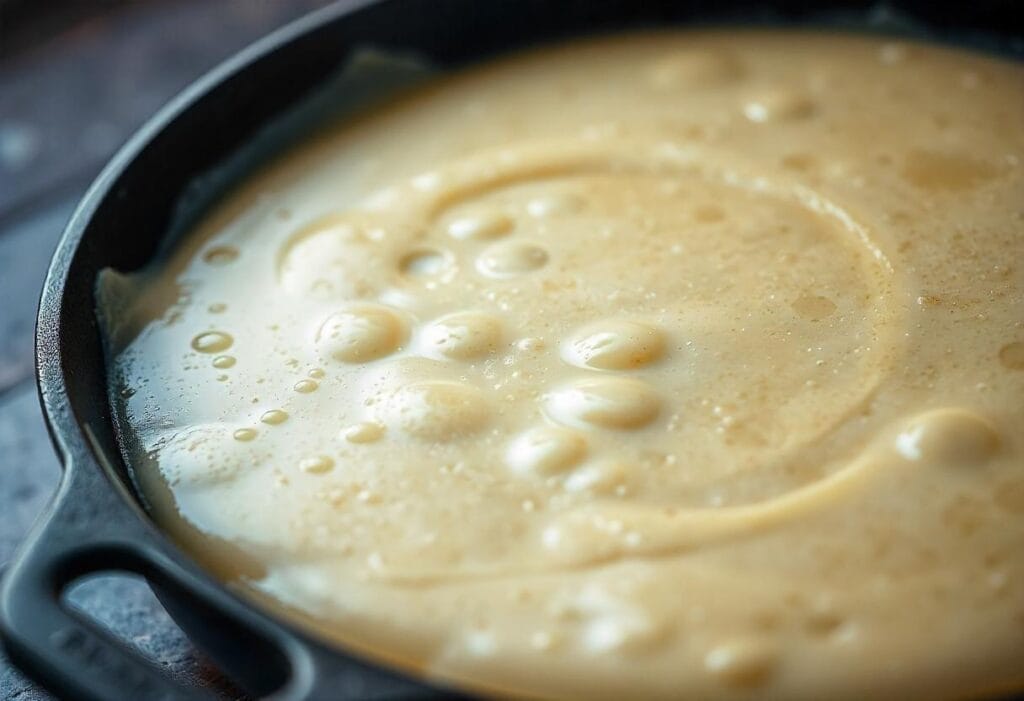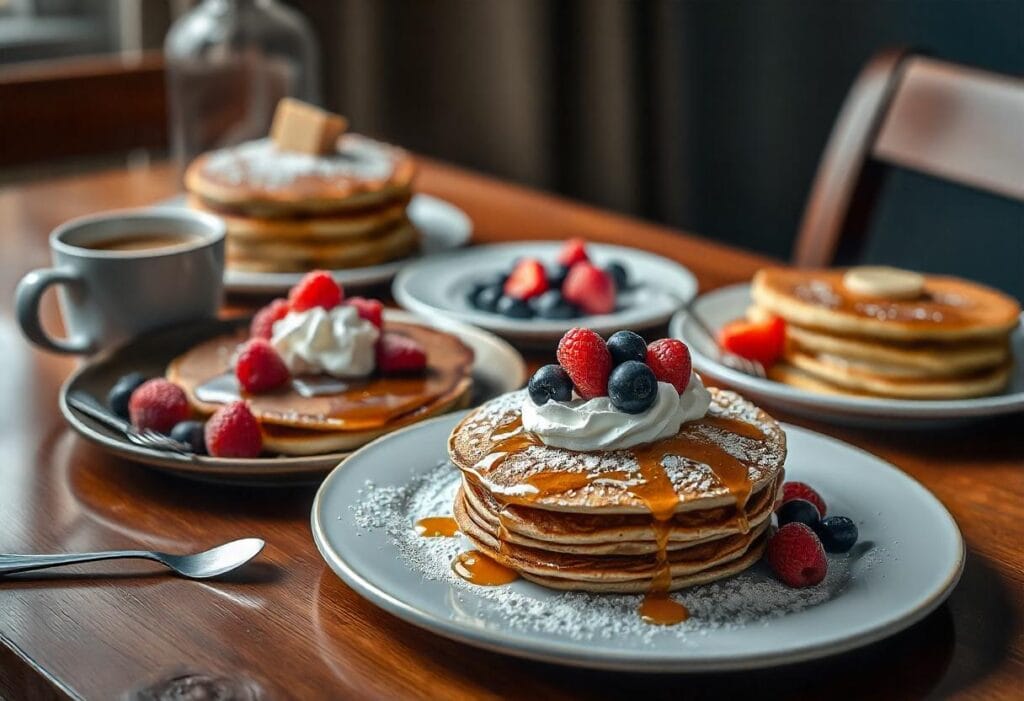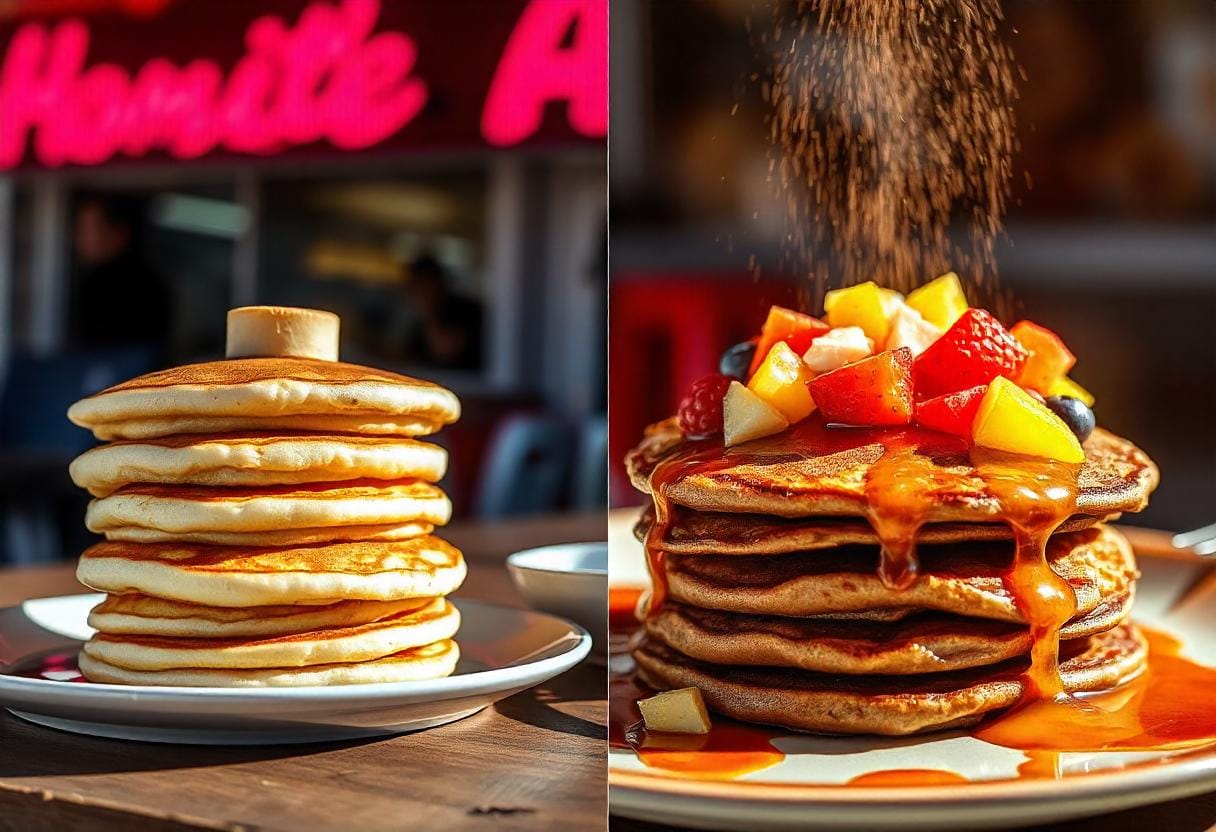Breakfast is often hailed as the most important meal of the day, and for good reason. But when pancakes and hotcakes take center stage, things can get a little confusing. Are they the same thing with different names, or are there subtle differences that make each unique? If you’ve ever wondered about this, you’re in the right place. Let’s break down the mystery of pancakes vs. hotcakes! 🥞
Introduction: Pancakes vs. Hotcakes
Let’s face it—pancakes and hotcakes sound interchangeable, and they often are. But as with many things in life, the details matter. While both start with similar ingredients and are cooked in a pan, the way they’re prepared, served, and even enjoyed can vary widely.
“Pancakes and hotcakes are like cousins at a family reunion—similar in many ways but with distinct personalities that set them apart.”
In this article, we’ll dig into what defines each one, their differences, and how to choose the best option for your breakfast table.
What Are Pancakes?
Pancakes are a classic breakfast staple enjoyed worldwide. They’re light, fluffy, and oh-so-versatile. But what exactly makes a pancake, well, a pancake?
Key Ingredients in Pancakes
The magic of pancakes lies in their simple yet effective ingredients. Let’s take a look:
| Ingredient | Purpose |
|---|---|
| All-purpose flour | Provides structure and texture. |
| Baking powder | Creates bubbles for fluffiness. |
| Eggs | Add richness and help bind the batter. |
| Milk | Hydrates the batter and adds moisture. |
| Sugar | Provides a hint of sweetness. |
| Salt | Balances and enhances the flavors. |
The result? A batter that’s light enough to yield airy pancakes but substantial enough to hold up to toppings like syrup and fruit.
Texture, Flavor, and Appearance of Pancakes
Pancakes are known for their soft, fluffy texture and golden-brown exterior. They’re slightly sweet, making them the perfect canvas for a variety of toppings.
“Think of pancakes as the blank canvas of breakfast—you can dress them up with syrup, berries, or even chocolate chips!”
Variations of Pancakes Around the World
Pancakes may be beloved in America, but they have unique variations across the globe:
- Crêpes (France): Thin and delicate, often filled with sweet or savory ingredients.
- Poffertjes (Netherlands): Small, fluffy pancakes served with powdered sugar.
- Blini (Russia): Mini pancakes often served with sour cream or caviar.
Each version adds its own cultural twist, making pancakes a universal favorite.
What Are Hotcakes?
Hotcakes, while similar to pancakes, have their own distinct identity. Popular in the southern United States and many parts of Asia, hotcakes are often thicker, heartier, and slightly sweeter.

Ingredients That Define Hotcakes
Hotcakes typically use ingredients similar to pancakes but with a few key differences:
| Ingredient | Purpose |
|---|---|
| All-purpose flour | Provides a denser base. |
| Sugar | Adds extra sweetness compared to pancakes. |
| Baking powder | Helps the hotcakes rise but not overly fluff up. |
| Milk or buttermilk | Adds richness and creaminess. |
Hotcakes often include more sugar and sometimes shortening, making them slightly denser and richer than pancakes.
Unique Characteristics of Hotcakes
Hotcakes are thicker than pancakes, with a denser, more cake-like texture. They don’t fluff up as much, but they’re incredibly satisfying. If pancakes are a fluffy cloud, hotcakes are the hearty, comforting hug you didn’t know you needed.
Regional Preferences for Hotcakes
In the southern United States, hotcakes are often associated with diner-style breakfasts. In Japan, the term “hotcakes” refers to tall, soufflé-like pancakes that have taken Instagram by storm. In Korea, Hotteok, a variation of hotcakes, are filled with sweet or savory ingredients and enjoyed as street food.
Comparing Pancakes and Hotcakes
Now that we’ve explored both, let’s put pancakes and hotcakes side by side to see how they stack up.
Differences in Texture and Thickness
| Characteristic | Pancakes | Hotcakes |
|---|---|---|
| Texture | Light and fluffy | Dense and hearty |
| Thickness | Thinner, spreads on the pan | Thicker, holds its shape |
How Pancakes and Hotcakes Are Served Differently
Pancakes often come stacked high, topped with butter and syrup, or adorned with fruit, whipped cream, and other toppings.
Hotcakes, on the other hand, are often served individually, sometimes with a dusting of powdered sugar or as part of a hearty meal with eggs and bacon.
“Pancakes say, ‘Let’s celebrate,’ while hotcakes whisper, ‘Let’s stay cozy.’”
Cooking Methods: Pancakes vs. Hotcakes
Pancakes cook quickly on medium heat, spreading thinly across the pan. Hotcakes require a slightly lower temperature and a bit more time to ensure the thicker batter cooks evenly.
Common Misconceptions About Pancakes and Hotcakes
The debate between pancakes and hotcakes often leads to misconceptions. Let’s clear up some of the most common ones so you can settle the confusion once and for all.
Are Pancakes and Hotcakes Interchangeable?
While the two are closely related, they’re not identical. Many people assume that pancakes and hotcakes can always be used interchangeably in recipes, but their textures and cooking requirements differ.
For example, if you’re using a pancake mix to make hotcakes, you might need to adjust the batter to make it thicker. Conversely, thinning hotcake batter is often necessary if you want to replicate pancake-like fluffiness.
Do Pancakes and Hotcakes Taste the Same?
At first bite, pancakes and hotcakes might seem similar, but subtle differences set them apart.
- Pancakes: Lightly sweet with a balanced flavor that works with sweet or savory toppings.
- Hotcakes: Richer and sweeter, often with a slightly more indulgent taste due to added sugar or fat in the mix.
« Think of it this way: pancakes are the cheerful morning friend, while hotcakes are the comforting hug you need after a long day. »
Solving the Debate: Pancake or Hotcake?
When it comes down to choosing between pancakes and hotcakes, it’s really about personal preference and the occasion. Here are some guidelines to help you decide.
When to Choose Pancakes
Pancakes are the go-to option when:
- You’re in the mood for something light and fluffy.
- You’re hosting a brunch and want a versatile dish.
- You love piling on toppings like fruit, whipped cream, and syrups.
Pancakes also cook faster, making them ideal for busy mornings when time is of the essence.
When to Opt for Hotcakes
Hotcakes are perfect for:
- Days when you crave a heartier, more filling breakfast.
- Pairing with savory sides like sausage, eggs, or hash browns.
- Impressing guests with a unique twist on traditional breakfast.
They’re also a great choice if you’re dining at a classic diner or experimenting with global variations like Japanese soufflé hotcakes.
The Role of Pancakes and Hotcakes in Global Cuisine
Pancakes and hotcakes aren’t just breakfast staples in Western countries—they’re cultural icons worldwide. Their adaptability makes them a favorite everywhere, but how they’re prepared and enjoyed can vary significantly.
Asian Variations of Hotcakes
In Japan, hotcakes have evolved into tall, jiggly soufflé pancakes. These cloud-like creations are made by whipping egg whites into stiff peaks before folding them into the batter. The result? Pancakes that are as fluffy as they are Instagram-worthy.
Korea offers a different take with Hotteok, a street-food hotcake stuffed with fillings like brown sugar, cinnamon, and crushed nuts. Savory versions with cheese or vegetables are equally popular, showcasing the versatility of the dish.
« In Asia, pancakes aren’t just food—they’re a celebration of creativity and flavor! »
European Pancakes: Thin and Versatile
While Americans love their thick, fluffy pancakes, Europeans often prefer thinner versions.
- France: Home of the crêpe, these thin pancakes can be sweet or savory, filled with everything from Nutella to ham and cheese.
- Germany: The Pfannkuchen is a thin, egg-heavy pancake that’s often enjoyed with apples or cherries.
- Russia: Mini pancakes called blini are traditionally served with sour cream and caviar, making them a luxurious treat.
Latin American Pancake Alternatives
In Latin America, pancakes and hotcakes take on unique forms:
- Cachapas (Venezuela): Made from fresh corn batter and folded with cheese, these resemble savory hotcakes.
- Arepas (Colombia): While not technically pancakes, their preparation and use as a base for toppings draw comparisons to the hotcake family.
Hotcakes and Pancakes: Nutrition and Dietary Considerations
When deciding between pancakes and hotcakes, nutritional content can be an important factor. Let’s explore how they stack up health-wise.
Nutritional Comparison
| Nutrient | Pancakes (Per Serving) | Hotcakes (Per Serving) |
|---|---|---|
| Calories | 190 | 220 |
| Sugar | 5g | 8g |
| Protein | 3g | 4g |
| Total Fat | 3g | 6g |
| Fiber | 2g | 1g |
Key Takeaways:
- Pancakes are generally lighter and have fewer calories.
- Hotcakes are sweeter and richer, making them more indulgent.
Adapting Recipes for Dietary Preferences
Whether you’re vegan, gluten-free, or simply looking for a healthier option, pancakes and hotcakes can be adapted to suit your needs.
Vegan Options
- Replace eggs with mashed bananas or flaxseed.
- Use plant-based milk like almond or soy milk.
Gluten-Free Options
- Substitute regular flour with almond or oat flour.
- Ensure your baking powder is gluten-free.
Low-Calorie Swaps
- Reduce sugar by half and add natural sweeteners like honey or stevia.
- Use skim milk instead of whole milk.
Creative Ways to Serve Pancakes and Hotcakes
One of the best things about pancakes and hotcakes is their versatility. You can serve them traditionally or get creative with your toppings and presentations.

Sweet Toppings for Pancakes and Hotcakes
The classic butter-and-syrup combo never goes out of style, but here are a few ways to elevate your breakfast game:
- Fresh Fruits: Add sliced bananas, strawberries, or blueberries for a refreshing touch.
- Chocolate and Nut Butters: Drizzle with Nutella or peanut butter for a rich, decadent twist.
- Whipped Cream: A dollop of whipped cream adds a light, airy texture.
Pro Tip: Sprinkle powdered sugar or cinnamon on top for an elegant finish.
Savory Options for Hotcakes
Hotcakes can easily transition into savory dishes:
- Eggs and Bacon: Serve hotcakes alongside scrambled eggs and crispy bacon for a hearty breakfast.
- Avocado and Salsa: Top with sliced avocado, salsa, and a dollop of sour cream for a Tex-Mex-inspired dish.
- Herb Butter: Mix fresh herbs into softened butter and spread it over warm hotcakes.
« Savory hotcakes are proof that breakfast can break the rules—and still taste amazing! »
Layered Creations: Turning Pancakes into Masterpieces
If you’re feeling adventurous, try layering pancakes or hotcakes to create something truly spectacular:
- Pancake Cakes: Stack pancakes with layers of cream and fruit to create a show-stopping dessert.
- Breakfast Sandwiches: Use two hotcakes as buns and fill with eggs, sausage, and cheese for a portable meal.
Cooking Tips for Pancakes and Hotcakes
Perfecting your pancake or hotcake game doesn’t just depend on the batter—it’s also about how you cook them.
The Ideal Griddle Temperature
- Pancakes: Medium heat (about 375°F) is best for even cooking without burning.
- Hotcakes: Slightly lower heat works better, as their thickness requires a longer cook time.
Pro Tip: Always grease your griddle lightly with butter or oil to prevent sticking.
When to Flip
Timing is crucial when flipping pancakes or hotcakes.
- Look for bubbles forming on the surface of your batter.
- Wait until the edges appear set and no longer shiny.
« The first flip is always the hardest, but practice makes perfect! »
Using the Right Tools
- Spatula: A wide, flat spatula makes flipping easier.
- Measuring Cups: Pour batter with precision to ensure uniform sizes.
- Ladle: Ideal for thicker hotcake batter to control portioning.
Pancakes and Hotcakes as Part of Tradition
Pancakes and hotcakes aren’t just foods—they’re cultural icons with deep roots in tradition.
Breakfast Traditions
In the United States, Sunday brunch often features pancakes piled high with syrup. Meanwhile, in the South, hotcakes are a diner staple served with hearty sides like sausage and hash browns.
Special Occasions
Many cultures celebrate pancakes and hotcakes as part of special events:
- Pancake Day (Shrove Tuesday): In many countries, this day is marked by feasting on pancakes before Lent.
- Pancake Races: In the UK, participants race while flipping pancakes in frying pans.
« Pancakes and hotcakes remind us that food is more than sustenance—it’s a connection to history and community. »
Frequently Asked Questions About Pancakes and Hotcakes
Let’s tackle some of the most common questions readers have about these breakfast staples.
Can You Use the Same Mix for Pancakes and Hotcakes?
Yes, but you might need to tweak the consistency. For hotcakes, use less liquid to create a thicker batter. For pancakes, add a bit more milk or water for a thinner consistency.
Which Is Healthier: Pancakes or Hotcakes?
Pancakes are generally lighter and have fewer calories because they contain less sugar and fat. Hotcakes, while richer, can be more indulgent.
Why Are Hotcakes More Popular in Some Regions?
Hotcakes are beloved in regions where hearty breakfasts are a tradition, such as the southern United States or parts of Asia. Their denser texture and richer flavor make them ideal for robust morning meals.
Conclusion: Pancakes and Hotcakes, Celebrating Their Unique Differences
Pancakes and hotcakes may share a family resemblance, but their differences make each one special. Whether you’re flipping light and fluffy pancakes for a crowd or savoring the dense, sweet comfort of hotcakes on a lazy weekend, both offer something unique to your breakfast table.
« Why choose one when you can enjoy both? Pancakes and hotcakes are like two sides of the same delicious coin—each worth savoring. »
So, the next time someone asks, “What’s the difference between a pancake and a hotcake?” you’ll have the perfect answer—and maybe even a recipe or two to share. 🥞

